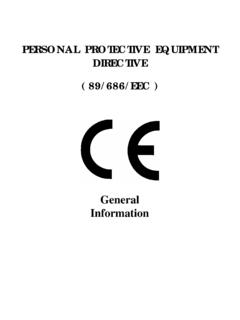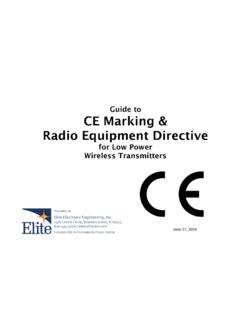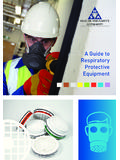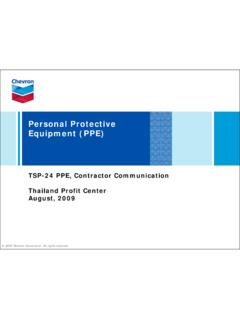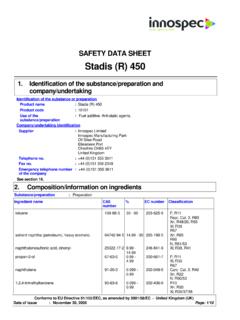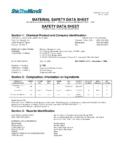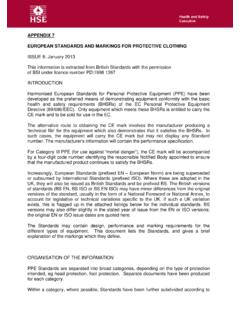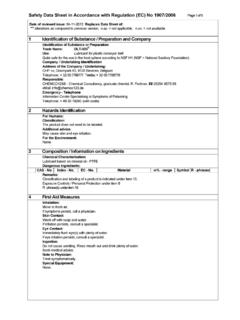Transcription of APPENDIX 2 EUROPEAN STANDARDS AND …
1 APPENDIX 2. EUROPEAN STANDARDS AND MARKINGS FOR hearing PROTECTION. ISSUE 8: January 2013. This information is extracted from British STANDARDS with the permission of BSI under licence number PD\1998 1367. INTRODUCTION. Harmonised EUROPEAN STANDARDS for Personal Protective Equipment (PPE) have been developed as the preferred means of demonstrating equipment conformity with the basic health and safety requirements (BHSRs) of the EC Personal Protective Equipment Directive (89/686/EEC). Only equipment which meets these BHSRs is entitled to carry the CE mark and to be sold for use in the EC.
2 The alternative route to obtaining the CE mark involves the manufacturer producing a 'technical file' for the equipment which also demonstrates that it satisfies the BHSRs. In such cases, the equipment will carry the CE mark but may not display any Standard number. The manufacturer's information will contain the performance specification. For Category III PPE (for use against mortal danger ), the CE mark will be accompanied by a four-digit code number identifying the responsible Notified Body appointed to ensure that the manufactured product continues to satisfy the BHSRs.
3 Increasingly, EUROPEAN STANDARDS (prefixed EN EUROPEAN Norm) are being superseded or subsumed by International STANDARDS (prefixed ISO). Where these are adopted in the UK, they will also be issued as British STANDARDS and be prefixed BS. The British versions of STANDARDS (BS EN, BS ISO or BS EN ISO) may have minor differences from the original versions of the standard, usually in the form of a National Foreword or National Annex, to account for legislative or technical variations specific to the UK. If such a UK variation exists, this is flagged up in the attached listings below for the individual STANDARDS .
4 BS. versions may also differ slightly in the stated year of issue from the EN or ISO versions;. the original EN or ISO issue dates are quoted here. The STANDARDS may contain design, performance and marking requirements for the different types of equipment. This document lists the STANDARDS , and gives a brief explanation of the markings which they define. ORGANISATION OF THE INFORMATION. PPE STANDARDS are separated into broad categories, depending on the type of protection intended, eg head protection, foot protection. Separate documents have been produced for each category.
5 Within a category, where possible, STANDARDS have been further subdivided according to the hazard (eg mechanical hazards, heat and flame) or component type (eg filters;. facepieces) as appropriate. Both current and recently superseded versions are listed, as equipment marked according to either version may be encountered in the field. Standard number and date are given, with the title (sometimes abridged). If a UK National variation applies to this standard, the nature of this variation is described. Markings and classifications defined in the Standard for that class of equipment are listed and briefly described.
6 Related STANDARDS , eg specific test methods which will not usually appear in the markings on equipment are listed separately at the end of each document. Pictograms and symbols for each type of equipment are included at the rear of the relevant document. STANDARDS FOR hearing PROTECTION. EN 352-1: 2002 - hearing protectors - Ear muffs In addition to the Standard number, manufacturer and model identification: indication of orientation of the ear muff, where required, eg 'TOP' and/or 'LEFT' and 'RIGHT'. EN 352-2:2002 - hearing protectors - Ear plugs Markings may only appear on the packaging.
7 In addition to the Standard number, manufacturer and model identification: whether disposable or re-useable fitting instructions nominal size of formable plugs, in range 5 to 14 mm. Left-right differentiation for custom moulded plugs EN 352-3:2002 - hearing protectors - Ear muffs attached to a safety helmet In addition to the Standard number, manufacturer and model identification: indication of orientation of the ear muff, where required, eg 'TOP' and/or 'LEFT' and 'RIGHT'. EN 352-4:2001 - hearing protectors - Ear muffs attached to a safety helmet Amended 2006.
8 As for EN 352-1. EN 352-5:2002 - hearing protectors Active noise reduction ear muffs As for EN 352-1. EN 352-6:2002 - hearing protectors - Ear muffs with electrical audio input As for EN 352-1. EN 352-7:2002 - hearing protectors level dependent ear plugs As for EN 352-2. EN 352-8:2008 - hearing protectors entertainment audio earmuffs As for EN 352-2. OTHER STANDARDS RELEVANT TO hearing PROTECTION. Occupational equipment is unlikely to be marked with these Standard numbers, but they may contain useful information on equipment performance or test methods.
9 EN 458:2004 hearing protectors- Selection, use, care and maintenance EN ISO 4869-2:1995 Acoustics hearing protectors Part 2: Estimation of effective A-weighted sound pressure levels when hearing protectors are worn EN ISO 4869-3:2007 Acoustics hearing protectors Part 3: Measurement of insertion loss of ear-muff type protectors using an acoustic test fixture EN ISO 4869-4:2000 Acoustics - hearing protectors - Part 4: Measurement of effective sound pressure levels for level-dependent sound- restoration ear-muffs DD ISO TS 4869-5: Acoustics hearing protectors Part 5: Method for 2006 estimation of noise reduction using fitting by inexperienced test subjects EN 13819-1:2002 hearing protectors Testing - Physical test methods EN 13819-2:2002 hearing protectors Testing - Acoustic test methods EN 24869-1:1992 Sound attenuation of hearing protectors.
10 Subjective method of measurement EN 24869-3:1993 Simplified method for measurement of insertion loss of ear muffs










